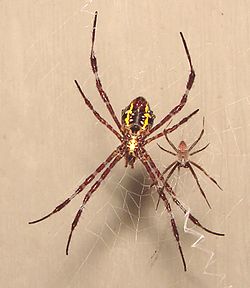| Argiope appensa | |
|---|---|
 | |
| On Hawai'i | |
| Scientific classification | |
| Domain: | Eukaryota |
| Kingdom: | Animalia |
| Phylum: | Arthropoda |
| Subphylum: | Chelicerata |
| Class: | Arachnida |
| Order: | Araneae |
| Infraorder: | Araneomorphae |
| Family: | Araneidae |
| Genus: | Argiope |
| Species: | A. appensa |
| Binomial name | |
| Argiope appensa (Walckenaer, 1841) [1] | |
| Synonyms [1] | |
| |
Argiope appensa, also referred to as the Hawaiian garden spider [2] or banana spider, is an orb-weaving spider belonging to the family Araneidae.





